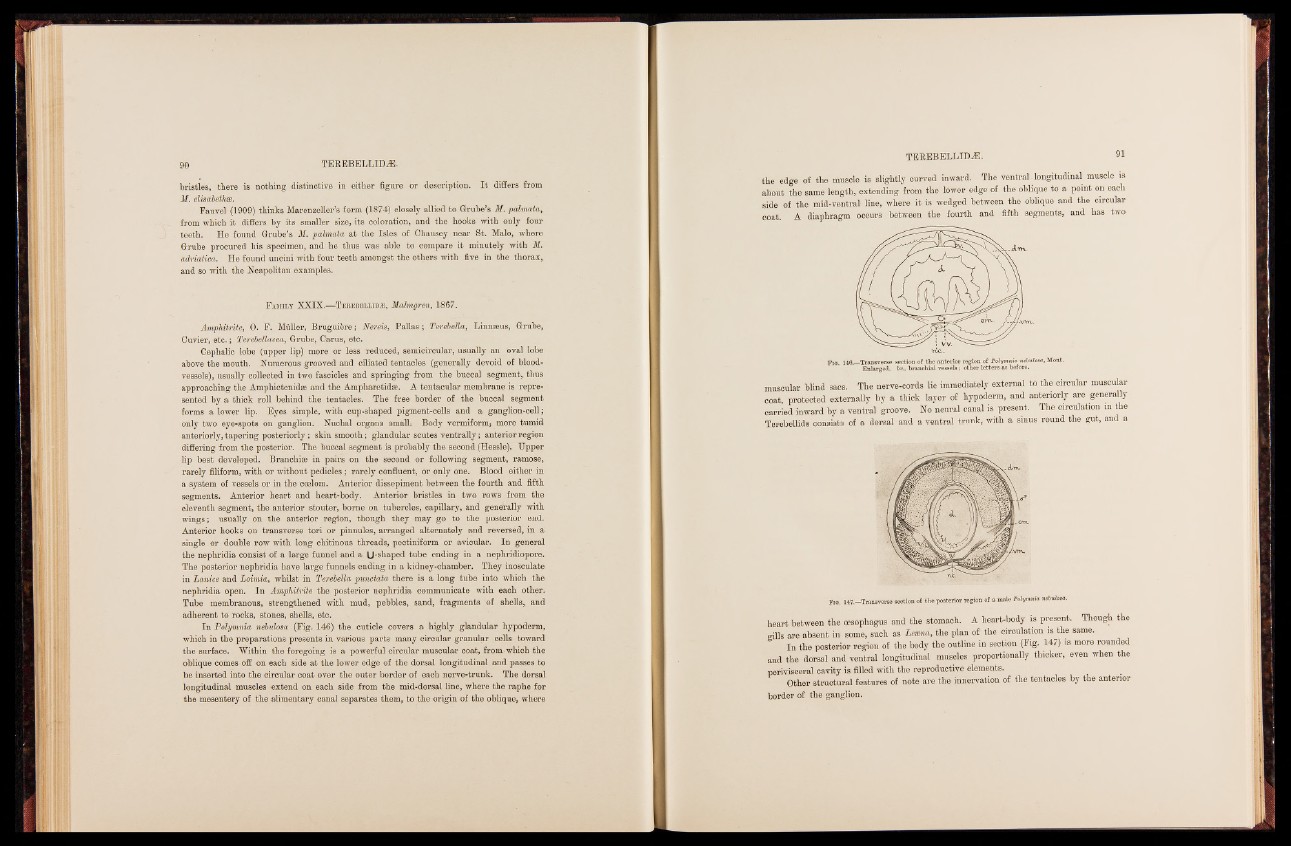
bristles, there is nothing distinctive in either figure or description. It differs from
M. elisabethse.
Fauvel (1909) thinks Marenzeller’s form (1874) closely allied to Grube’s M. palmata,
from which it differs by its smaller size, its coloration, and the hooks with only four
teeth. He found Grube’s M. palmata at the Isles of Chausey near St. Malo, where
Grube procured his specimen, and he thus was able to compare it minutely with M.
adriatica. He found uncini with four teeth amongst the others with five in the thorax,
and so with the Neapolitan examples.
Family XXIX.—Terebellidæ, Malmgren, 1867.
Amphitrite, O. F. Müller, Bruguière; Nereis, Pallas; Terebella, Linnæus, Grube,
Cuvier, etc. ; Terebellacea, Grube, Carus, etc.
Cephalic lobe (upper lip) more or less reduced, semicircular, usually an oval lobe
above the mouth. Numerous grooved and ciliated tentacles (generally devoid of bloodvessels),
usually collected in two fascicles and springing from the buccal segment, thus
approaching the Amphictenidæ and the Ampharetidæ. A tentacular membrane is represented
by a thick roll behind the tentacles. The free border of the buccal segment
forms a lower lip. Eyes simple, with cup-shaped pigment-cells and a ganglion-cell;
only two eye-spots on ganglion. Nuchal organs small. Body vermiform, more tumid
anteriorly, tapering posteriorly ; skin smooth ; glandular scutes ventrally ; anterior region
differing from the posterior. The buccal segment is probably the second (Hessle). Upper
lip best developed. Branchiæ in pairs on the second or following segment, ramose,
rarely filiform, with or without pedicles ; rarely confluent, or only one. Blood either in
a system of vessels or in the coelom. Anterior dissepiment between the fourth and fifth
segments. Anterior heart and heart-body. Anterior bristles in two rows from the
eleventh segment, the anterior stouter, borne on tubercles, capillary, and generally with
wings; usually on the anterior region, though they may go to the posterior end.
Anterior hooks on transverse tori or pinnules, arranged alternately and reversed, in a
single or double row with long chitinous threads, pectiniform or avicular. In general
the nephridia consist of a large funnel and a U-shaped tube ending in a nephridiopore.
The posterior nephridia have large funnels ending in a kidney-chamber. They inosculate
in Lamce and Loimia, whilst in Terebella punctata there is a long tube into which the
nephridia open. In Amphitrite the posterior nephridia communicate with each other.
Tube membranous, strengthened with mud, pebbles, sand, fragments of shells, and
adherent to rocks, stones, shells, etc.
In Polymnia nebulosa (Fig. 146) the cuticle covers a highly glandular hypoderm,
which in the preparations presents in various parts many circular granular cells toward
the surface. Within the foregoing is a powerful circular muscular coat, from-which the
oblique comes off on each side at the lower edge of the dorsal longitudinal and passes to
be inserted into the circular coat over the outer border of each nerve-trunk. The dorsal
longitudinal muscles extend on each side from the mid-dorsal line, where the raphe for
the mesentery of the alimentary canal separates them, to the origin of the oblique, where
the edge of the muscle is slightly curved inward. The ventral longitudinal muscle is
about the same length, extending from the lower edge of the oblique to a point on each
side of the mid-ventral line, where it is wedged between the oblique and the circular
coat. A diaphragm occurs between the fourth and fifth segments, and has two
Fig. 146.—Transverse section of the anterior regi Enlarged, bv., branchial vessels; otheorn loeftt eProsl yams nbieaf onreeb.ulosa, Mont.
muscular blind sacs. The nerve-cords lie immediately external to the ciroular muscular
coat, protected externally by a thick layer of hypoderm. and anteriorly are generally
carried inward by a ventral groove. No neural canal is present. The circulation m the
Terebellids consists of a dorsal and a ventral trunk, with a sinus round the gut, and a
Fig. 147.—Transverse section of the posterior region of a male Polymnia nebulosa.
heart between the oesophagus and the stomach. A heart-body is present. Though the
gills are absent in some, such as Leima, the plan of the circulation is the same.
In the posterior region of the body the outline in section (Fig. 147) is more rounded
and the dorsal and ventral longitudinal muscles proportionally thicker, even when the
perivisceral cavity is filled with the reproductive elements.
Other structural features of note are the innervation of the tentacles by the anterior
border of the ganglion.